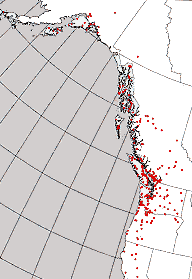forum
library
tutorial
contact

The Problem with Hatcheries
by Jim Lichatowich & Seth ZuckermanSalmon Nation, 1999
|
the film forum library tutorial contact |

|
The Problem with Hatcheriesby Jim Lichatowich & Seth ZuckermanSalmon Nation, 1999 |
 It might seem counter-intuitive that hatcheries could actually harm the species being propagated. After all, if the problem is too few fish, why not simply hatch some more? The reason lies in the subtle connections between elements of the salmon system.
It might seem counter-intuitive that hatcheries could actually harm the species being propagated. After all, if the problem is too few fish, why not simply hatch some more? The reason lies in the subtle connections between elements of the salmon system.
The earliest hatcheries were simply egg-incubating stations that released tiny fry into the streams, hoping to increase fish populations by reducing the mortality of eggs incubated in stream-bottom gravels. By the second decade of the twentieth century, managers began to feed the fry and raise them to fingerling size before turning them loose. But the diet they received - a mixture of fish offal, horse meat, tripe, and condemned pork and beef - was ineffective, and even spread disease through the tightly packed schools of fish.
It wasn't until 1960, with the advent of pelletized feed made from fishmeal, that hatcheries had significant success in raising large numbers of fish to large fingerling size or even to the smolting stage, when the fish begin to adapt to salt water for their adult lives.
Even as they became more proficient at raising juvenile fish, the hatcheries were actually undermining the vitality of the wild stocks of salmon that they hoped to supplement. One problem was rooted in "carrying capacity," the maximum number of fish that a particular stream can support. As hatcheries infused rivers with millions of fingerlings for their journeys to the sea, the hatchery fry came to compete with the wild fish traveling oceanward at the same time. At times, there simply wasn't enough food to nourish all of the young fish, to the detriment of both wild and hatchery stocks.
When hatchery-bred fish return as adults and interbreed with wild salmon, they produce offspring that are less hardy than their purely wild counterparts. Each river and tributary has a distinct strain of fish, the product of generations of natural selection in which the fish that best fit a particular environment were the most likely to return and reproduce, passing on their genes to the next generation. For instance, fish whose spawning journey takes them just a few miles from the ocean enter the river nearly ready to mate, while their cousins destined for spawning grounds far inland will not be ready to lay their eggs until months after they re-enter fresh water. In addition, wild fish often possess resistance to the parasites and diseases of their native streams.
Sometimes the genetic wires get crossed accidentally, as when hatchery fish stray into another stream upon returning to spawn. In many other cases, managers transplanted fingerlings from one river system to another. Either way, the hatchery-bred salmon mated with wild native fish and diluted their local adaptations. For example, native coho salmon possess resistance to a particular parasite that is present in coastal Oregon's Nehalem River. Young hatchery coho from another river, where the parasite isn't prevalent, were planted in a tributary of the Nehalem for several years. Later, when adults were collected there, their offspring proved less resistant to the parasite than the wild stocks but not as susceptible as the hatchery transplants. Researchers concluded that the mixing of the stocks had reduced the population's resistance to the parasite. In another case, scientists found that eggs laid by coho of hatchery descent that spawned in the wild were less likely to survive than the eggs of wild fish. The reason? Apparently, the hatchery fish were spawning earlier in the year, which was not as well matched to the conditions of that river as the native salmon's timing.
Finally, even if the hatchery program yields many adults, if those adult fish are targeted by a commercial fishery that captures fish from a combination of stocks - in the ocean where fish from many rivers mingle together, or in the lower reaches of a large river system like the Columbia, for example - the weaker wild stocks will be overharvested. Regulators will devise rules that will allow, say, two-thirds of the stronger stocks to be taken. But those rules will result in a two-thirds harvest of the weaker stocks, whose population will be harmed by such a large loss.
Currently, some 80 percent of the adult spawners returning to the Columbia River are the product of hatcheries. Regulations that serve the majority of salmon are unlikely to match the needs of the wild 20 percent.
An indiscriminate hatchery program treats fish like interchangeable parts in a large machine. The first precaution of intelligent tinkering, counseled conservationist Aldo Leopold, is to save all the parts. Neglecting this precaution, we have unbalanced an intricate system and placed the salmon in danger.
Additional materials adapted from Salmon Nation appear on the following pages:
Behind That Farmed Salmon Steak
A Natural History of the Pacific Salmon
Recalling Celilo
Visualizing Salmon Nation: Maps
learn more on topics covered in the film
see the video
read the script
learn the songs
discussion forum
